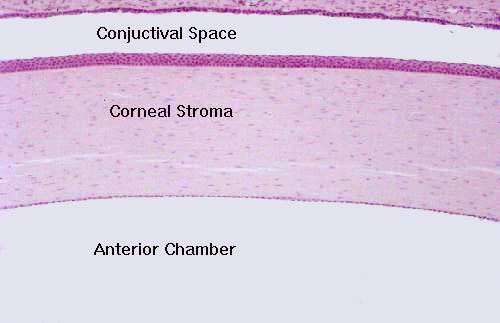Cornea
 The cornea is the principal light refracting structure of the eye.
Structurally, most of it is composed of long bundles of collagen
precisely interlaced and laid down in very regular lamellae. This is
the substantia propria or corneal stroma, about 90% of
the cornea's thickness.
The cornea is the principal light refracting structure of the eye.
Structurally, most of it is composed of long bundles of collagen
precisely interlaced and laid down in very regular lamellae. This is
the substantia propria or corneal stroma, about 90% of
the cornea's thickness.
On the outer surface, facing the outside world, is the corneal
epithelium. This is a stratified squamous epithelium with 5 to 7
layers of cells. This epithelium is very sensitive, as it has many
free nerve endings in it; damage to the cornea caused by abrasion is
very painful. The typical epithelial property of rapid proliferation
permits such damage to be rapidly repaired. (It also makes the cornea
sensitive to irradiation, and one symptom of overexposure to
radioactivity—or other insults that affect proliferative cells—is
corneal opacification.)
Like other epithelial sheets, the corneal surface is avascular.
This has some clinical implications, too. The lack of blood vessels
means the cornea is isolated from the immune system, and corneal
transplants hence are not subjected to the normal process of graft
rejection seen with other organs.
The inner surface of the cornea is lined with a single layer of
epithelial cells, the corneal endothelium. Both the outer and
inner epithelial layers rest on distinct basement membranes, which
cannot be seen at the magnification used here.
Monkey eye; H&E stain, paraffin section

Close This Window
 The cornea is the principal light refracting structure of the eye.
Structurally, most of it is composed of long bundles of collagen
precisely interlaced and laid down in very regular lamellae. This is
the substantia propria or corneal stroma, about 90% of
the cornea's thickness.
The cornea is the principal light refracting structure of the eye.
Structurally, most of it is composed of long bundles of collagen
precisely interlaced and laid down in very regular lamellae. This is
the substantia propria or corneal stroma, about 90% of
the cornea's thickness.
